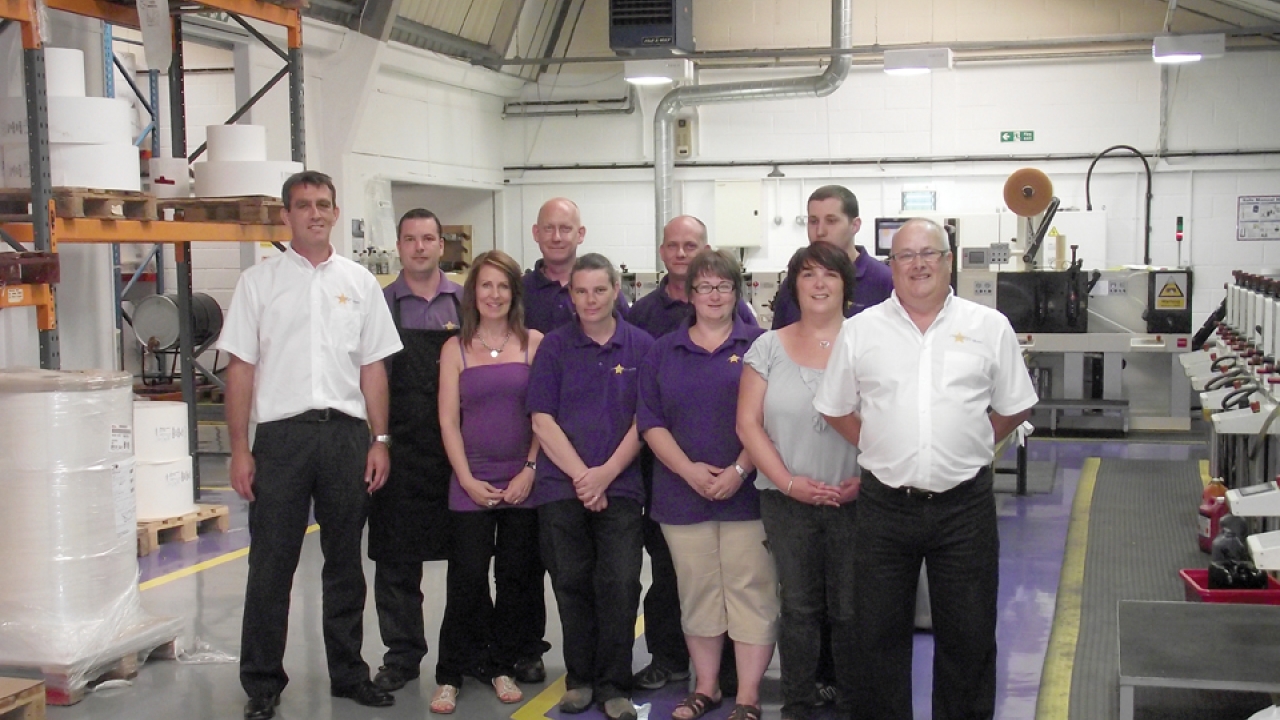Mission rises above the competition

Mission Labels has established itself as a supplier to the supermarkets through a commitment to service and BRC accreditation. Andy Thomas reports
Selling labels to the notoriously price and quality-conscious UK supermarkets is one of the toughest challenges any label converter can face. But Mission Label has carved out a successful niche based on the highest quality water-based flexo production and investment in BRC/IOP hygiene accreditation.
This 11-strong company is run by four directors: Dave Humphrey, technical director; Fiona Humphrey, finance; Martin Gearing, operations; and Sue Gearing, pre-production. ‘We’ve always been hands on. Sue and I have rewound all night, and we can all cover each other,’ says Fiona Humphrey.
The four came together in 2002 following the collapse of Wabe Labels. Fiona Humphrey continues, ‘We wanted to make a go of our own label company, and we had only one week to get the bank to back us’.
The part of Sussex where Mission Labels is located has always been something of a labels powerhouse, and all four Mission directors had previously worked at Arun Labels, a company which was later bought by Tinsley Robor and spawned the Wabe Labels operation.
Sue Gearing and Fiona Humphrey were both working at Tinsley Robor in pre-press and production respectively, and Dave Humphrey was working as an engineer when he heard the liquidators were going into Wabe. ‘The customer base was the same as at Arun, and we all thought, "the four of us can make a go of it’’.' Their enthusiasm was well founded: the company went from a turnover of 400,000 pounds in the first year to 1.7 million pounds in 2010.
Serving supermarkets
From the outset, the four directors were focused on the UK supermarkets and their regulatory requirements, in particular the British Retail Consortium’s hygiene standard (BRC/IOP). ‘It was obvious which way the industry was going – if you did not have BRC you could not work for the supermarkets, so BRC was next on the horizon,’ says Dave Humphrey. ‘It became a central part of our 10 year plan.’
Undertaking BRC looked a daunting proposition for a company the size of Mission. But once the process started, the company’s employees realized it fitted with the wider goal of making the business more efficient.
‘When you look at it, a lot is standard operating practice, such as consistent quality standards,’ explains Martin Gearing. ‘BRC at first seems too much paperwork. But then it becomes smoother and works more efficiently and people start getting the hang of it. We are more efficient and generate less waste as a result. The lads on the workshop floor understand that doing the paperwork keeps their jobs secure.’
Most of Mission Label’s work comes through recommendations rather than a sales process. ‘Now BRC will keep the customers we have and help us get more,’ says Martin Gearing.
Supplier partnerships
Mission Labels bought its first Nilpeter press five years ago, then another in 2009. ‘I can’t reiterate more how Nilpeter have helped us out,’ says Dave Humphrey. ‘They are such a good team of people with their backup, training and support and it’s important to have equipment you know will function consistently.
‘Herma has helped us out as well. This just demonstrates that it is necessary today to have suppliers that are prepared to work in partnership.’
Dave Humphrey picks out John Hill at Herma for his technical support. ‘He is superb. He helped us out tremendously in establishing our traceability regime. It shows that BRC makes partnership pay, because suppliers have to supply to given set up standards. The Herma facilities are open to us, and they often say ‘we will find out for you’ and you know it will be done.’
Another supplier picked out for praise is inks and coatings supplier Pulse, which has provided ongoing advice on migration and adhesives issues. Pulse used Mission’s labels on its stand at Labelexpo Europe to demonstrate the state of the art in water-based flexography.
Water everywhere
Mission Label’s two Nilpeter presses have replaced all their previous machines. Both are 8-color FB3300s, and the latest is the ‘S’ model, with servo-driven plate cylinder. ‘They are both great machines, but with the servo press we are in registration straight away and it runs that much smoother,’ says Martin Gearing.
The press is fitted with a turnbar, and de-lam and re-lam unit. ‘We can print on the adhesive where necessary and where the film needs to act as a total barrier to migration,’ says Martin Gearing.
The presses print some of the best water-based flexographic work this writer has seen, and all out of four process colors. UV is used only on the varnish station. Dave Humphrey says some of the company’s labels have been mistaken for offset by print buyers.
‘Sue is a genius on pre-press, and this is what makes the difference,’ says Dave Humphrey. ‘For instance, we can get a solid black and process black on the same plate.’ The company has recently invested 10,000 pounds in pre-press equipment – roughly one quarter of the total investment in buildings and services.
Plates are analogue, and although CTP is always under consideration, ‘with the new Harlequin RIP we are already approaching that quality,’ says Sue Gearing.
Daylight lamps are on all day throughout the plant, which costs a lot of money, but allows accurate color matching between proofs and press output.
The choice to use water-based inks came from the team’s industry experience. They have all been involved in the labels industry for 25 years and have used water-based inks since being at Arun Labels. ‘With waterbased inks we have no migration issues at all and are able to offer keener prices,’ says Dave Humphrey. ‘We have no emissions and the anilox is much easier to clean – in fact it’s easier to clean down the press as a whole.’ Aniloxes and press parts are cleaned in a FlexoWash system. ‘Color matches absolutely depend on the cleanliness of the anilox.’
As well as Sue Gearing’s pre-press expertise, Dave Humphrey puts the quality of Mission Label’s output down to the new plates and inks available. ‘Water-based plates are much better than they were. They are more expensive but much better.’ Plates are mounted on a Heaford plate mounter.
Although run lengths are generally decreasing, Mission Label will not consider digital. ‘Despite making plates, we are still cheaper than digital on runs above 1,500 labels,’ says Dave Humphrey. ‘What sets us apart is the speed we can make high quality plates. We can produce six plates in an hour and go from PDF to production in one hour 30 minutes! This allows us to make very late changes. If we do need digital, we have Marsh Label down the road.’
Service is key
A company the size of Mission Label only survives in the ferociously competitive world of the UK supermarket industry through service. ‘Everything is handled in-house, allowing full control of quality and a high throughput from PDF to production,’ says Sue Gearing. ‘We do both short and long runs, but service is the key. We have all come in at two in the morning to finish a job.’
The company operates mostly in the food and fresh produce sector and around 20 percent of jobs are 8-color. The ability to respond quickly to an early crop of lettuces or strawberries, for example, is key. ‘Most fresh produce work is on a three day turnaround which requires a flexible production board,’ says Sue Gearing. ‘We do not aim to be the cheapest and we can’t be a Paragon. We survive through our service.’
The press operators make a key contribution to the overall efficiency of the operation, being fully involved in how the presses are run and the workflow around them. It was their suggestion that all the cutters are numbered, for example. All tools are now color coded – even the brooms, ‘so we know that a broom will always be there!’ laughs Dave Humphrey. ‘The onus is now more on the group. Everybody takes responsibility and we sort problems as they arise. If one shift leaves the press dirty, they have to clean it up.’
On the finishing side, installing the two Nilpeter presses meant moving from roll widths of 250 to 330mm and production speeds increasing from 50 to 80-120 m/min, finishing three rolls an hour and not two. This required further investment and in 2010 Mission installed new rewinders from Rotoflex and ABG.
Mission also offers an after sales technical service. ‘It is vital that all customers have confidence in the fact that Mission will ensure all of their labels are fit for purpose,’ says Martin Gearing.
Into the future
Mission Label is one of those inspirational companies which demonstrates why this industry has still not undergone the mass consolidation seen in the other segments of the package print industry. Small converters can move fast in implementing new technologies and workflows, can focus completely on service and work closely with key suppliers to achieve top quality output, allowing them to find a niche and thrive in the complex supermarket eco-system.
Sustainability
Mission Labels has not come across demands from its customers for ‘sustainable’ products, but is always preparing. ‘We have trialed sustainable adhesives from Herma, which can be recycled, but it does not yet include hot melts,’ says Dave Humphrey.
For liner recycling, Mission is promoting the Finat-sponsored Cycle For Green (C4G) initiative to its customers.
Pictured: (L-R) Martin Gearing, operations director; Scott Cornwall, printer; Sue Gearing, pre-press/production director; Mark Catley, printer; Heidi Pannel, stock control; Graham West, re-wind/warehouse team leader; Jo Grove, office co-ordinator; Rob Woodley, rewind; Fiona Warwick, financial director; Dave Humphrey, technical director
This article was published in L&L issue 1, 2012
Stay up to date
Subscribe to the free Label News newsletter and receive the latest content every week. We'll never share your email address.

